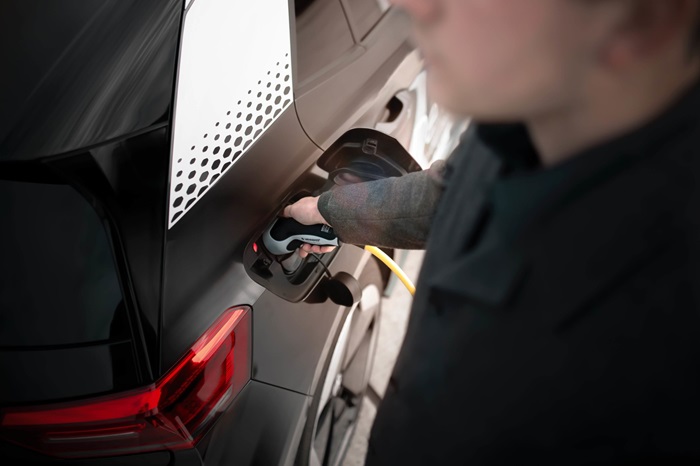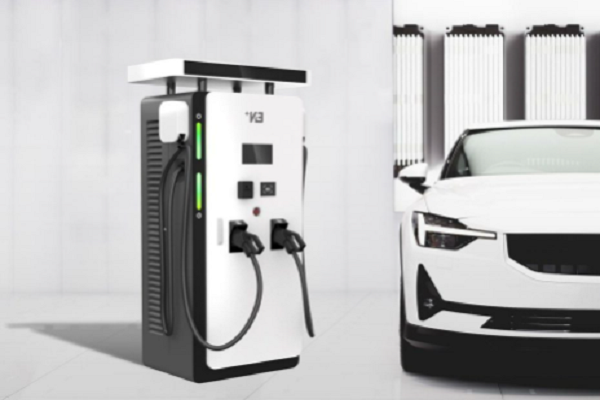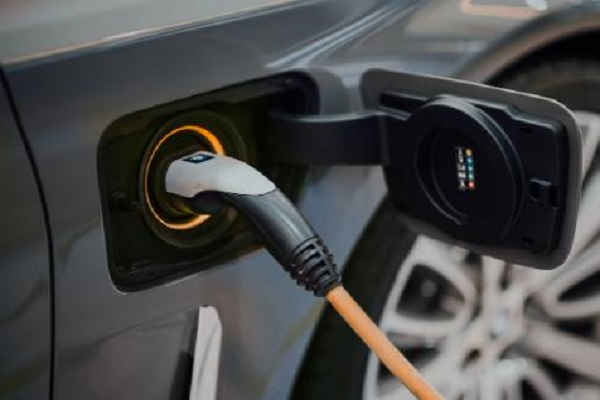Discover Everything About Level 3 Electric Vehicle Charger
The electric vehicle (EV) landscape is rapidly evolving, and with it, the need for efficient and powerful charging solutions. Among the various charging levels available, Level 3 stands out as the fastest and most convenient option for EV owners on the go.
This essay delves into the world of Level 3 EV chargers, exploring their key features, benefits, and considerations.
What is a Level 3 charger, and How Does it Work?

A Level 3 charger, also known as a DC fast charger or rapid charger, is a high-powered charging station capable of delivering a significant amount of electricity to an electric vehicle (EV) in a short amount of time. Unlike Level 1 and Level 2 chargers, which use alternating current (AC), Level 3 chargers utilize direct current (DC) to charge the vehicle’s battery directly.
Level 3 chargers are typically found at public charging stations and are designed to provide rapid charging for EVs, making them ideal for drivers who need to charge their vehicles quickly, such as during long-distance travel or while running errands.
The operation of a Level 3 charger involves converting AC power from the electrical grid into DC power, which is then delivered directly to the vehicle’s battery. This direct transfer of DC power allows for much faster charging speeds compared to Level 1 and Level 2 chargers, significantly reducing the time required to recharge an EV.
Understanding the Power Output of Level 3 Chargers
Level 3 chargers are characterized by their high power output, typically ranging from 50 kW to 350 kW or more, depending on the charger’s specifications and the capabilities of the EV being charged. This high power output enables Level 3 chargers to deliver rapid charging speeds, allowing drivers to add hundreds of miles of range to their EVs in a matter of minutes.
The power output of a Level 3 charger is significantly higher than that of Level 1 and Level 2 chargers, making it the fastest charging option available for EVs. However, due to the high power requirements and specialized equipment involved, Level 3 chargers are generally more expensive to install and operate than Level 1 and Level 2 chargers.
Comparing Level 3 Charging to Level 2 Charging
Here’s a quick comparison of Level 3 chargers against the familiar Level 2 option:
| Feature | Level 3 Charger | Level 2 Charger |
| Power Delivery | High-voltage DC (50-350 kW+) | 240-volt AC |
| Charging Speed | Significantly faster | Faster than Level 1 |
| Typical Charging Time | Minutes | Hours |
| Cost per kWh | Generally higher | Varies depending on location |
| Availability | Limited availability | More widely available |
While tempting for their speed, Level 3 chargers aren’t as readily available as Level 1 or Level 2 chargers. They’re typically found at designated charging stations along highways or in urban areas. Additionally, the electricity cost per kWh might be higher for Level 3 charging compared to Level 2 options.
Benefits of Using a Level 3 EV Charger
While Level 1 and Level 2 chargers are essential for everyday EV charging, Level 3 chargers offer a whole new level of convenience – speed. Here’s why Level 3 charging might be a game-changer for you.

Reduced Charge Time with Level 3 Charger
The most compelling benefit of Level 3 chargers is undoubtedly their lightning-fast charging speeds. Unlike Level 1 chargers that take hours and Level 2 chargers that require several hours, Level 3 chargers can replenish a significant portion of your EV’s battery, often up to 80%, in just 20-30 minutes. This makes them perfect for:
- Long road trips: no more extended stopovers for charging! Level 3 chargers allow you to quickly top up your battery and get back on the road faster.
- Quick errands: Need a quick boost before heading out? A Level 3 charger can provide enough juice for your immediate needs without a lengthy wait.
- Peace of mind: Level 3 chargers can alleviate “range anxiety” by offering a safety net on longer journeys. Even if you’re running low on battery, a quick stop at a Level 3 station can get you back on track.
How Level 3 Chargers Benefit EV Drivers
The speed advantage of Level 3 chargers translates to several benefits for EV drivers:
- Increased flexibility: With faster charging times, you’re not as restricted by your battery level when planning trips.
- Reduced downtime: Spending less time plugged in means more time on the road.
- Enhanced practicality: Level 3 charging makes EVs even more suitable for everyday use, including longer commutes or spontaneous outings.
Cost Considerations for Installing a Level 3 Charger
Installing a Level 3 charger involves several cost considerations, including equipment costs, installation expenses, and long-term savings.

Exploring the Installation Costs of Level 3 Chargers
- Equipment Costs: Level 3 chargers themselves can be expensive due to their high-power output and specialized components. The cost of the charger can vary based on factors such as brand, power output, and additional features. Generally, Level 3 chargers are more expensive than Level 1 and Level 2 chargers.
- Electrical Infrastructure: Installing a Level 3 charger requires robust electrical infrastructure capable of handling high-power loads. This may involve upgrades to the electrical system, including wiring, circuit breakers, and distribution panels, to accommodate the charger’s power requirements. The complexity of these upgrades can significantly impact installation costs.
- Permitting and Compliance: There may be additional costs associated with obtaining permits and ensuring compliance with local building codes and regulations. This can include fees for permits, inspections, and compliance documentation, depending on the jurisdiction.
- Site Preparation: Site preparation may be necessary to accommodate the Level 3 charger, including excavation, foundation work, and the installation of mounting hardware. Site-specific factors such as terrain, accessibility, and existing infrastructure can influence these costs.
Analyzing the Long-Term Savings with a Level 3 Charger
While the upfront costs of installing a Level 3 charger can be substantial, there are potential long-term savings to consider:
- Time Savings: The rapid charging capabilities of Level 3 chargers can significantly reduce the time spent waiting for a recharge compared to slower charging options. For commercial operators or fleet owners, this time savings can translate into increased productivity and reduced downtime for EVs.
- Operational Efficiency: Level 3 chargers are designed for high-volume charging, making them efficient for busy charging locations such as highways, urban areas, and commercial facilities. The ability to recharge multiple vehicles quickly can increase throughput and revenue generation for charging operators.
- Increased Use: Drivers with limited access to overnight charging options may use EVs more frequently as a result of the ease of rapid charging that Level 3 chargers provide. This can lead to higher EV adoption rates and reduced reliance on fossil fuels, contributing to long-term sustainability goals.
- Competitive Advantage: Businesses and organizations that offer Level 3 charging facilities may gain a competitive advantage by attracting EV drivers seeking fast and convenient charging options. This can enhance customer satisfaction, loyalty, and brand reputation over time.
Key Differences Between Level 3 and DC Fast Chargers
There actually isn’t a key difference between Level 3 chargers and DC Fast Chargers! They are essentially the same thing.

Level 3 is a standardized term used within the industry to define a specific charging level based on power output and charging speed. It refers to chargers that deliver high-voltage Direct Current (DC) power directly to an electric vehicle’s battery, bypassing the car’s onboard converter. This significantly reduces charging times compared to Level 1 and Level 2 chargers, which utilize Alternating Current (AC).
DC Fast Charger is another commonly used term to describe the same technology. It emphasizes the battery’s ability to receive fast charging by delivering DC power directly.
| Term | Definition |
| Level 3 Charger | Standardized term for chargers delivering high-voltage DC power for fast charging |
| DC Fast Charger | A descriptive term highlighting the fast charging achieved with DC power delivery |
Both terms refer to the same technology and offer the following benefits:
- Significantly faster charging times compared to Level 1 and Level 2 chargers.
- Ideal for long-distance travel where quick top-ups are essential.
- Suitable for situations where time is limited and a quick boost is needed.
Understanding the Technology Behind DC Fast Charging
As mentioned earlier, DC fast charging utilizes DC power. Here’s a simplified explanation:
- AC vs. DC: Household outlets deliver Alternating Current (AC), which constantly changes direction. Electric vehicle batteries, however, use Direct Current (DC) with a constant flow in one direction.
- Onboard Converter: A typical Level 1 or Level 2 charger delivers AC power. The car’s onboard converter then transforms this AC power into DC for battery charging. This conversion process takes time.
- DC Fast Charging Bypass: DC fast chargers eliminate this conversion step by delivering DC power directly to the battery, significantly accelerating the charging process.
Comparing the Efficiency of Level 3 Chargers to DC Fast Chargers
While DC fast charging offers undeniable speed advantages, it’s important to consider a few points regarding efficiency:
- Heat Generation: The high power involved in DC fast charging can generate more heat compared to slower charging methods. This can potentially impact battery health over time, although modern EVs have safeguards to mitigate this.
- Grid Strain: The high power demands of DC fast chargers can strain existing electrical grids, especially during peak usage periods. Implementing smart charging technologies and utilizing renewable energy sources can help optimize efficiency and minimize grid strain.
Challenges and Solutions in Level 3 EV Charging Infrastructure
Expanding level 3 charging infrastructure is critical to meet the growing demand for electric vehicles and support long-distance travel. Level 3 EV charging infrastructure faces many challenges. However, many innovative solutions are emerging to solve these problems.

1. Addressing the Need for Charging Infrastructure Expansion
While Level 3 chargers offer the ultimate charging speed for electric vehicles, widespread adoption faces several challenges. Here’s a look at the roadblocks and potential solutions:
Challenges:
- Cost and Infrastructure Requirements: Level 3 chargers necessitate significant upfront investment due to their high-power demands. Upgrading electrical grids and installing heavy-duty equipment can be expensive, hindering widespread deployment.
- Limited Availability: Compared to Level 1 and Level 2 chargers, Level 3 options are far less prevalent. This creates a barrier for long-distance travel as EV drivers might struggle to find stations, especially on less-traveled routes.
- Grid Strain and Energy Management: The high power requirements of Level 3 chargers can strain existing electrical grids, particularly during peak demand periods. Efficient energy management solutions are needed to integrate these chargers without overloading the grid.
- Standardization and Compatibility: While CCS and CHAdeMO are the dominant DC fast charging connector standards, a lack of complete uniformity can cause compatibility issues for some EVs.
Solutions:
- Government Incentives and Public-Private Partnerships: Government incentives and subsidies can encourage investment in Level 3 charging infrastructure, making it more financially viable for businesses and organizations. Public-private partnerships can also share the financial burden and accelerate deployment.
- Strategic Placement and Corridor Development: Prioritizing Level 3 charger placement along major highways and travel corridors can significantly improve long-distance EV travel feasibility. This can incentivize longer trips and reduce “range anxiety” for EV drivers.
- Smart Charging and Grid Integration: Implementing smart charging technologies can optimize energy usage and minimize grid strain. This involves integrating chargers with renewable energy sources and utilizing dynamic pricing models to encourage charging during off-peak hours.
- Technological Advancements: Research and development in high-power, compact, and cost-effective Level 3 charger designs can make them more accessible and easier to install, promoting wider adoption. Additionally, advancements in battery technology that enable faster charging times could lessen reliance solely on Level 3 infrastructure.
2. Exploring Innovations in Level 3 Charging Solutions
Beyond traditional Level 3 chargers, innovative solutions are emerging to address some of the existing challenges:
Ultra-Fast Charging (UFC): These next-generation chargers boast even higher power outputs (potentially exceeding 350 kW) and promise even faster charging times. However, these are still under development and require further infrastructure upgrades.
Megawatt Charging Systems: Concepts for megawatt charging systems are being explored, targeting extremely fast charging for commercial EVs like heavy-duty trucks. These solutions are in their early stages but hold promise for long-haul electric transportation.
Mobile and Pop-Up Chargers: Concepts for mobile and pop-up Level 3 charging stations are being explored to address temporary needs or provide fast charging in areas with limited infrastructure.
How to Choose the Right Level 3 EV Charger for Your Electric Vehicle
Although Level 3 chargers are typically not owned by individual EV drivers due to their high cost and installation requirements, knowing how to choose the best one can be helpful for businesses or organizations considering offering DC fast charging at their stations.

- Factors to Consider When Selecting a Level 3 Charger
Charging Speed: Evaluate the charging speed of the Level 3 charger, which is typically measured in kilowatts (kW). Higher charging speeds can significantly reduce charging time, but be sure to check your EV’s compatibility with the charger’s power output.
Connector Compatibility: Ensure that the Level 3 charger’s connector is compatible with your electric vehicle. Common connector types include CHAdeMO, CCS (Combo Connector), and Tesla Supercharger. Verify which connector type your vehicle supports before selecting a charger.
Manufacturer Reputation: Choose a reputable manufacturer with a track record of producing reliable and high-quality Level 3 chargers. Research customer reviews, warranties, and customer support options to assess the manufacturer’s reputation.
Network Accessibility: Consider the availability and accessibility of Level 3 charging networks in your area or along your typical driving routes. Choosing a charger that is part of a widespread charging network can provide greater convenience and peace of mind, especially for long-distance travel.
Scalability: If you anticipate future growth in your electric vehicle fleet or charging needs, consider the scalability of the Level 3 charger. Choose a charger that can accommodate future expansion or additional charging stations as needed.
Smart Features: Look for Level 3 chargers with smart features such as remote monitoring, scheduling, and payment integration. These features can enhance the user experience, streamline management, and optimize charger utilization.
- Comparing Different Level 3 Charger Models and Features
When comparing different Level 3 charger models and features, consider the following:
Power Output: Compare the charging speed and power output of different Level 3 charger models to ensure compatibility with your EV’s charging capabilities and requirements.
Connector Type: Determine which connector type is compatible with your electric vehicle and select a charger that supports that connector type. Some Level 3 chargers may offer multiple connector options for greater flexibility.
User Interface: Evaluate the user interface and control features of Level 3 chargers, such as touchscreen displays, LED indicators, and interactive menus. Choose a charger with an intuitive interface that is easy to use and navigate.
Safety Features: Consider safety features such as overcurrent protection, ground fault detection, and thermal management systems. These features help ensure safe and reliable charging operations, protecting both the charger and the electric vehicle.
Networking Capabilities: Assess networking capabilities such as connectivity to charging management platforms, remote monitoring, and software updates. These features enable efficient management, monitoring, and maintenance of Level 3 charging infrastructure.
Best Practices for Maintaining and Maximizing Your Level 3 Charger
Although individual EV drivers do not typically own Level 3 chargers, it is crucial for businesses and organizations that run these powerful charging stations to understand proper maintenance procedures.

- Tips for Ensuring Optimal Performance of Your Level 3 Charger
Regular Inspections: Implement a routine inspection schedule to check for any physical damage to cables, connectors, or the charger unit itself. Look for signs of wear, corrosion, or overheating.
Preventative Maintenance: Schedule preventative maintenance by qualified technicians to ensure proper functionality and identify any potential issues before they escalate. This might include cleaning and tightening electrical connections, checking cooling systems, and updating software if applicable.
Environmental Considerations: Since Level 3 chargers generate significant heat, proper ventilation is crucial. Ensure the charging station has adequate airflow to prevent overheating and maintain optimal performance.
Compliance with Regulations: Level 3 charger installations must adhere to strict electrical safety regulations. Regularly review and update safety protocols as needed.
- Understanding the Importance of Regular Maintenance for Level 3 Chargers
Safety First: Ignoring maintenance can lead to potential safety hazards like overheating or electrical malfunctions. Regular inspections and preventative measures can help mitigate these risks.
Performance Optimization: Proper maintenance ensures your Level 3 chargers deliver optimal charging speeds and efficiency. Addressing minor issues before they become major problems helps maintain peak performance.
Reduced Downtime: A well-maintained Level 3 charger is less likely to experience unexpected breakdowns. This minimizes downtime and ensures the station remains available for EV drivers.
Extended Lifespan: Regular maintenance practices can significantly extend the lifespan of your Level 3 chargers, ultimately delaying the need for costly replacements.
Level 3 charging represents a significant leap forward in EV charging technology, offering unparalleled speed and convenience.
While considerations regarding compatibility and cost exist, the undeniable benefits of Level 3 make it a compelling choice for EV owners seeking a rapid and efficient charging experience.
As the EV landscape continues to evolve, Level 3 charging is poised to play a pivotal role in facilitating widespread EV adoption and propelling the future of sustainable transportation.

Henry Michael is a leading expert in EV charging station research, specializing in innovative solutions for electric vehicle infrastructure. With a passion for sustainability and technological advancement, he is dedicated to advancing the accessibility and efficiency of EV charging worldwide.







